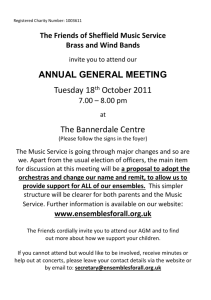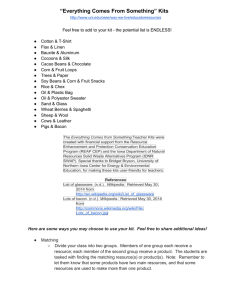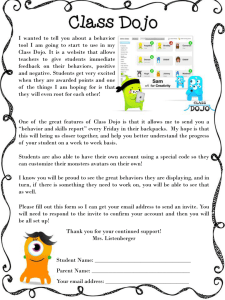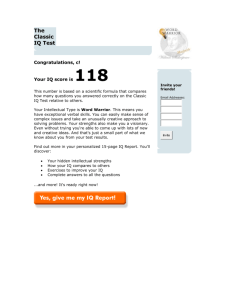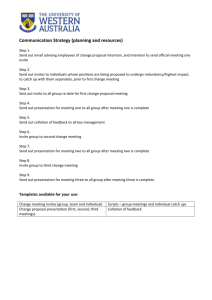Green Holiday Open House: Lessons Learned PRACTICAL WAYS TO CREATE MEANING
advertisement
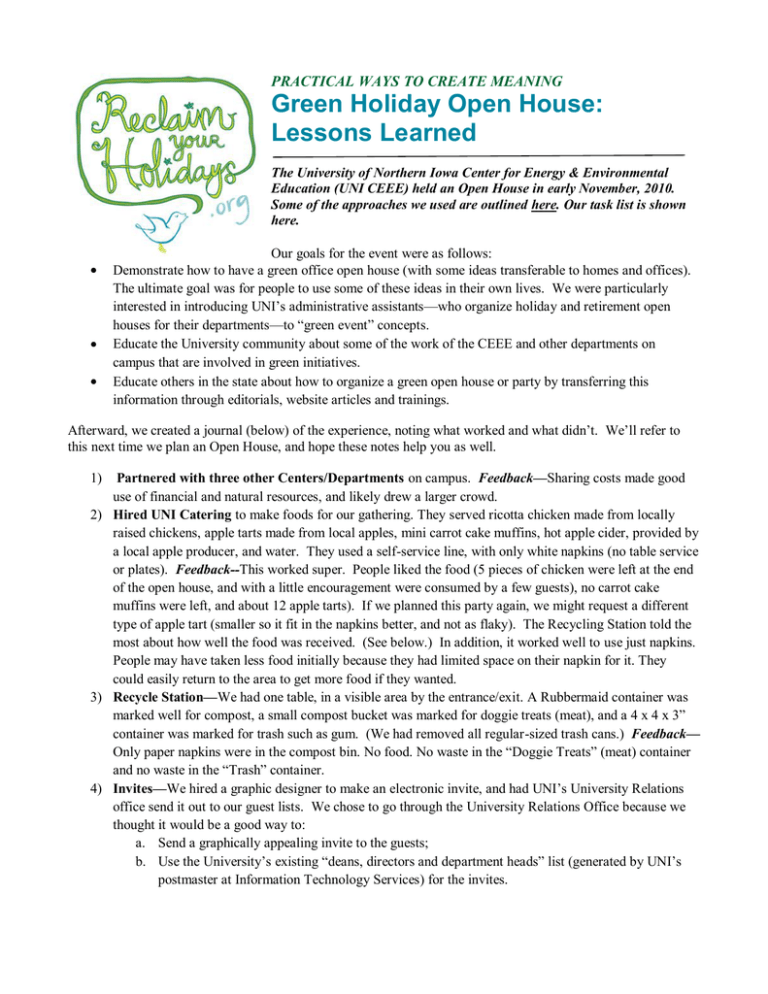
PRACTICAL WAYS TO CREATE MEANING Green Holiday Open House: Lessons Learned The University of Northern Iowa Center for Energy & Environmental Education (UNI CEEE) held an Open House in early November, 2010. Some of the approaches we used are outlined here. Our task list is shown here. Our goals for the event were as follows: Demonstrate how to have a green office open house (with some ideas transferable to homes and offices). The ultimate goal was for people to use some of these ideas in their own lives. We were particularly interested in introducing UNI’s administrative assistants—who organize holiday and retirement open houses for their departments—to “green event” concepts. Educate the University community about some of the work of the CEEE and other departments on campus that are involved in green initiatives. Educate others in the state about how to organize a green open house or party by transferring this information through editorials, website articles and trainings. Afterward, we created a journal (below) of the experience, noting what worked and what didn’t. We’ll refer to this next time we plan an Open House, and hope these notes help you as well. 1) Partnered with three other Centers/Departments on campus. Feedback—Sharing costs made good use of financial and natural resources, and likely drew a larger crowd. 2) Hired UNI Catering to make foods for our gathering. They served ricotta chicken made from locally raised chickens, apple tarts made from local apples, mini carrot cake muffins, hot apple cider, provided by a local apple producer, and water. They used a self-service line, with only white napkins (no table service or plates). Feedback--This worked super. People liked the food (5 pieces of chicken were left at the end of the open house, and with a little encouragement were consumed by a few guests), no carrot cake muffins were left, and about 12 apple tarts). If we planned this party again, we might request a different type of apple tart (smaller so it fit in the napkins better, and not as flaky). The Recycling Station told the most about how well the food was received. (See below.) In addition, it worked well to use just napkins. People may have taken less food initially because they had limited space on their napkin for it. They could easily return to the area to get more food if they wanted. 3) Recycle Station—We had one table, in a visible area by the entrance/exit. A Rubbermaid container was marked well for compost, a small compost bucket was marked for doggie treats (meat), and a 4 x 4 x 3” container was marked for trash such as gum. (We had removed all regular-sized trash cans.) Feedback— Only paper napkins were in the compost bin. No food. No waste in the “Doggie Treats” (meat) container and no waste in the “Trash” container. 4) Invites—We hired a graphic designer to make an electronic invite, and had UNI’s University Relations office send it out to our guest lists. We chose to go through the University Relations Office because we thought it would be a good way to: a. Send a graphically appealing invite to the guests; b. Use the University’s existing “deans, directors and department heads” list (generated by UNI’s postmaster at Information Technology Services) for the invites. We emailed most invites on a Tuesday morning. We were advised that Tuesdays and Wednesdays were the best times to send such communication. Feedback—The invite was very attractive, but was difficult for University Relations to send out. The design didn’t transfer very well from the graphic designer to the university’s computers. Other technical problems came up—recipients may have received the invite in different ways—sometimes requiring them to accept or reject potentially unsafe materials. My sense is that plenty of invitees never saw the graphic components of the invite because of these technical difficulties. We also resent the invite again before the RSVPs were due, but had to send it to our entire list because we had no way of knowing who had already responded to the invite. If we were to do this again, we would generate our own invite list (and do our best to capture the deans, directors, department heads and others we want to invite). We also would either send out an evite from the web or send simple emails (to no more than 20 invitees per email). If we did it with University Relations, we would request a database to collect names of those who RSVP as well as a function so the reminder would only be sent to those who hadn’t responded to the first invite. In hindsight, we should have also invited administrative assistants directly, generating our own lists and not trying to use the existing university lists. (The university lists don’t target the same people we were trying to target, and for budgetary reasons we could not just invite the entire university community.) In addition, our Subject line in the email could have said something about “Learn how to host a green open house.” That may have attracted more to open the email invite. 5) Reminder email—About 24 hours before the event, we emailed those planning to attend and reminded them to bring their mug. We also informed them that gifts would be available for purchase. Feedback— Good idea. Most everyone in attendance brought their mug. 6) RSVP/Attendance—To reduce food waste, we requested an RSVP. Except for the technical difficulties, this worked very well. About 85 RSVPed, and we ordered food for 105…and had just the right amount. 7) Green gifts—We set up a station with green gift ideas (wool socks and sweater, florescent lights, bpafree water bottle, jar of granola, crank flashlight, battery recharger, rechargeable bike lights, local foods cookbook, local hard cider, etc.). We set up another station with green gift ideas available for purchase. This station included such items as clothes drying racks, LED strings of lights, children’s environmental picture books and rechargeable bike lights. Feedback—We’d probably do this again. 8) Decorations—We gave all partners a 2’x8’ table which they could use to display their work/promote their activities. These were located around the periphery of the circular room. In the center, we had grouped three plants from the CEEE and put LED lights on them. We had two dowels with signs on them stuck into the soil of the largest plant, explaining how to decorate for a green party by using LED lights and by grouping natural materials together. In addition to the plants, we added a few pumpkins and prairie grasses. Five or six small tables with chairs were in the center of the room as well. Each had natural decorations on it (prairie grasses in vases or a clear glass container filled with pine cones). We planned to rent tablecloths for a more elegant and festive look, but didn’t need them. Feedback—The space looked simple but festive. 9) Education—As mentioned earlier, displays were set up around the outside of the gathering place. We placed the Reclaim Your Holidays display in a prime position, and many seemed interested in its content. Feedback—We needed someone to welcome people as they came in, invite them to the “what do you love” poster to write down something they love about the holidays, tell them where the Reclaim Your Holidays display was, explain the various partners had tables around the periphery of the room, that they could sign up to get recipes for the local foods served at the event, etc. 10) Timeline—We started serious planning about two months prior to the event, and hoped to have invites out one month before the event. They, however, took much longer to get ready for mailing than anticipated because of the technical difficulties and the time involved to generate (and avoid duplicates on) the mailing list. We emailed invites about two weeks prior to the event, and hoped to have RSVPs one week prior so local foods could be ordered with no difficulty. RSVPs weren’t in until three business days before the event. The day of the event, the three committee planners met at nine and decorated the space, moving chairs and tables, stringing lights, etc. It took almost three hours to decorate. Feedback— Start early. Email invites one month in advance. 11) Other opportunities—We tried videotaping a few components of the event using our personal cameras. Feedback: There would have been many opportunities to videotape, but we had little experience and ran out of time. We would plan ahead so this opportunity would not be missed. We might also contact local media and invite them to attend. 12) Costs Food $3.75/person x 105 = $393.75 Welcome to Open House $20.80 Poster and other signage Invite graphic design $150 Decorations Plants were already in the CEEE, Committee members donated prairie plants, twigs, branches, pine cones, LED lights, etc. Staff time Contributed to project TOTAL: $564.55 13) Evaluation—We know of several immediate outcomes from the project. a. Approximately 90% of the guests brought their own mugs, as directed, to reduce waste. This was a change in behavior. b. Approximately 20% of the guests signed up to get copies of the recipes for the foods served at the event. c. Approximately 5% of the guests purchased green gifts to give to families or friends. d. The majority of attendees said, in a follow-up evaluation, that they were “very familiar” with environmental sustainability concepts both before and after the Open House. e. The majority of attendees indicated, in the follow-up evaluation, that they changed their holidays in several ways (checking two or more items in a 12-item list of actions), either by taking this action for the first time or doing more of this action than they had in the past. Reclaim your Holidays is a project of the University of Northern Iowa Center for Energy & Environmental Education. Support for this project is provided by the Resource Enhancement and Protection Program (REAP) Conservation Education Program and Iowa Department of Natural Resources Solid Waste Alternatives Program Agreement Number 10-G550-41FL. Any opinions, findings, conclusions, or recommendations expressed herein are those of the author(s) and do not necessarily reflect the views of IDNR. For more information, visit www.ReclaimYourHolidays.org.
